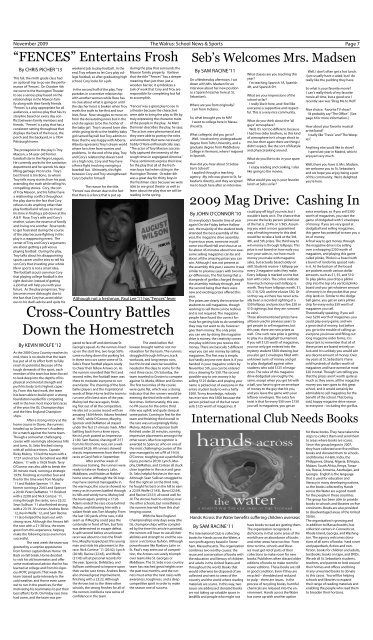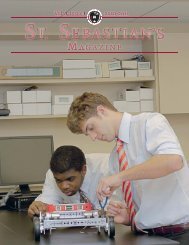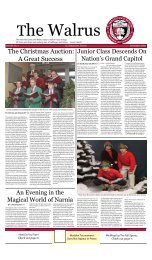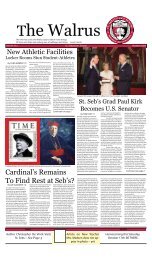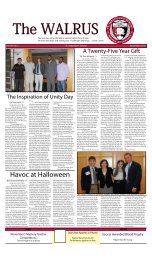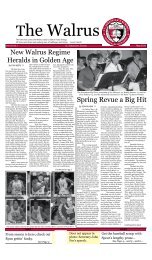congregate
November 2009 - St. Sebastian's School
November 2009 - St. Sebastian's School
- No tags were found...
You also want an ePaper? Increase the reach of your titles
YUMPU automatically turns print PDFs into web optimized ePapers that Google loves.
November 2009 The Walrus: School News & Sports<br />
Page 7<br />
“FENCES” Entertains Frosh<br />
By CHRIS PICHER ‘13<br />
This fall, the ninth grade class had<br />
an optional trip to go see the performance<br />
of “Fences’. On October 4th<br />
we went to the Hunington Theater<br />
to see a serious play based on the<br />
relationships in the Maxson family<br />
along with their family friends.<br />
“Fences’ is a play appropriate for all<br />
audiences, a serious play that has its<br />
storyline based on every day conflict<br />
between family members and<br />
friends. “Fences’ is a play that has a<br />
consistent setting throughout that<br />
displays the back of the house, the<br />
porch and the backyard, in a 1954<br />
Pittsburgh home.<br />
The protagonist in the play is Troy<br />
Maxson, a 54-year-old former<br />
baseball star in the Negro Leagues.<br />
He currently works for the sanitation<br />
department and he spends his days<br />
lifting garbage into trucks. Troy’s<br />
best friend is Jim Bono, to whom<br />
Troy tells many stories from his past,<br />
extending the truth while telling his<br />
compelling stories. Cory, the son<br />
of Troy Maxson, and his father have<br />
a relationship conflict throughout<br />
the play due to the fact that Cory<br />
refuses to do anything other than<br />
play football and refuses to invest<br />
his time in finding a job down at the<br />
A & P. Rose, Troy’s wife and Cory’s<br />
mother, values the essence of family<br />
and loving one another. Rose tends<br />
to get frustrated during the course<br />
of the play because fighting in this<br />
play is a reappearing event. The<br />
center of Troy and Cory’s arguments<br />
are about getting a job versus<br />
playing football. During the play,<br />
Troy talks about his disappointing<br />
sports career and he tries to tell his<br />
son Cory that investing your whole<br />
life in sports is not a smart idea.<br />
The football scouts convince Cory<br />
that playing college football is the<br />
right decision instead of getting<br />
a job that will help you with your<br />
future. As the play progresses, Troy<br />
becomes more distraught due to<br />
the fact that Cory has acted oblivious<br />
to his dad’s advice and quits his<br />
Cross-Country Battles<br />
Down the Homestretch<br />
By KEVIN WOLFE ‘12<br />
weekend job to play football. In the<br />
end, Troy refuses to let Cory play college<br />
football, so after graduating high<br />
school, Cory looks for a job.<br />
In the second half of the play, Troy<br />
partakes in a secretive relationship<br />
with another woman while Rose has<br />
no clue about what is going on until<br />
the day her heart is broken when Troy<br />
revels the truth to her first and true<br />
love, Rose. Rose struggles to move on<br />
from the devastating news but in the<br />
end she agrees to be the mother of<br />
the baby girl. Troy’s second lover dies<br />
while giving birth to the healthy baby<br />
girl named Raynell but Troy admits to<br />
Rose that he was happy with Alberta.<br />
Alberta represents Troy’s dream world<br />
where he is free from worries and<br />
problems. In the end of the play, Troy<br />
and Cory’s relationship doesn’t end<br />
on a high note, Cory and Troy have<br />
a fierce fight involving swinging a<br />
baseball bat. Ultimately, this fight<br />
between Cory and Troy strengthened<br />
Cory’s belief in himself.<br />
The reason for the title,<br />
“Fences’ was chosen due to the fact<br />
that there is a fence that is put up<br />
As the 2009 Cross Country reaches its<br />
end, there is no doubt that the team<br />
has put all of its effort forth to fully<br />
reach its potential. Because of the<br />
tough demands of the sport, each<br />
member of the team has been forced<br />
to look deep into the depths of his<br />
physical and mental strength and<br />
push his body to its highest capacity.<br />
From this hard work, the team<br />
has been able to build upon a strong<br />
foundation needed for competing<br />
well in the two most important races<br />
of the year: the ISL Championships<br />
and the New England Championships.<br />
After a strong victory at the<br />
home course in Dover, the runners<br />
headed up to Governor’s Academy<br />
for a match against the home team.<br />
Though a somewhat challenging<br />
course with seemingly obnoxious hills<br />
and turns, St. Sebs finished strong<br />
with all solid race times. Captain<br />
Ricky Mulroy `10 led the team with a<br />
17:37 and not too far behind was Will<br />
Adams `11 with a 19:05 finish. Terry<br />
O’Connor was also able to break the<br />
20 minute mark, running a strategic<br />
19:59. Finishing at number four and<br />
five for the time were Tom Murphy<br />
`11 and Robbie Spencer `11, the<br />
former running a 20:03 and Spencer<br />
a 20:40. Peter DeMatteo `11 finished<br />
with a 22:08 and Nick Cortese `11,<br />
rising through the ranks, ran a 22:22.<br />
Sean Sullivan `11 also finished strong<br />
with a 23:19. JV runners Andrew Bono<br />
`12, Kevin Wolfe `12, and Sam Racine<br />
`11 also helped the team out with<br />
strong races. Although the Arrows left<br />
the race with a 21-38 loss, the team<br />
grew from this experience, helping<br />
make the following races even more<br />
successful.<br />
The next week the team was<br />
greeted by a surprise appearance<br />
from former captain Brian Horne `09.<br />
Back on fall break, Horne decided<br />
to visit his old teammates and offer<br />
some motivational advice that he has<br />
learned at college and from his rigorous<br />
ROTC program. That week the<br />
team trained quite intensely in the<br />
cold weather, and Horne even came<br />
out to run in the practices, further<br />
motivating his teammates to put their<br />
best efforts forth. On Friday race time<br />
had come, and the team was prepared<br />
to face off and dominate St.<br />
George’s squad. As the runners lined<br />
up on the start line, two large SUVs<br />
came rushing down the parking lot.<br />
In these two cars came some of St.<br />
Sebs’s finest football players ready<br />
to cheer their fellow Arrows on. As<br />
the runners rounded their first and<br />
second miles, the football team was<br />
there to motivate everyone to run<br />
even faster. The cheering of the footballer<br />
players and the inspirational<br />
words of Brian Horne led the team to<br />
run one of its best races of the year.<br />
Mulroy led the race again, finishing<br />
first out of all the competitors.<br />
He also set a course record with an<br />
amazing 18:04 finish. Adams finished<br />
at 19:05, while O’Connor, Murphy,<br />
Spencer and DeMatteo all stayed<br />
under the fast 21-minute mark. After<br />
battling back from a knee injury,<br />
Kevin Lynch posted an impressive<br />
21:00. Sam Racine, shaving off 2:17<br />
from his first home race, ran a wellearned<br />
24:26. All runners showed<br />
drastic improvements from their first<br />
races at Caryl Park in September.<br />
After another week of<br />
strenuous training, the runners were<br />
ready to take on Roxbury Latin,<br />
Middlesex, and Nobles at Nobles’<br />
home course. Although the 5K loop<br />
may have seemed manageable in<br />
the warmups, the course showed no<br />
mercy as its runners battled through<br />
its hills and windy turns. Mulroy led<br />
the team again, posting a 17:26.<br />
Adams ended the race close behind<br />
Mulroy, and following him with a<br />
valiant finish was Tom Murphy. From<br />
the last 100 yards of the race, it did<br />
seem as if Murphy could pass the<br />
contender in front of him, but Tom<br />
was determined to escape defeat.<br />
A split second before an unknown<br />
racer was about to cross the finish<br />
line, Murphy leaped past this young<br />
man and stole his placement in the<br />
race. Nick Cortese `11 (20:42), Lynch<br />
(20:48), Racine (22:43), and Wolfe<br />
(21:43) all set personal records for<br />
the year. Spencer, DeMatteo, and<br />
Sullivan continued to improve upon<br />
their earlier race times. Andrew Bono<br />
also showed great improvement,<br />
finishing with a 22:22. Although<br />
the Arrows lost to the three other<br />
schools, the strong finishes for all of<br />
the runners instilled a new sense of<br />
confidence in the team.<br />
during the play that surrounds the<br />
Maxson family property. I believe<br />
that the title ““Fences’” has a deeper<br />
meaning than just then just a<br />
wooden barrier; it symbolizes a<br />
task of work that Cory and Troy are<br />
responsible for completing but fail<br />
to accomplish.<br />
“Fences’ was a great play to see in<br />
a theater because the characters<br />
were able to bring the play to life by<br />
truly expressing the character traits<br />
of the people in the play. As Matt<br />
Donovan describes the play, he says,<br />
“The actors were phenomenal and<br />
they were able to portray the roles<br />
and emotions that were necessary.”<br />
Teddy O’Hara enthusiastically says,<br />
“The actor of Tory Maxson successfully<br />
captured the intensity of the<br />
rough times in segregated America.”<br />
These sentiments express their love<br />
for the play that all of the freshman<br />
boys had when sitting in the<br />
Hunington Theater. October 4th<br />
was a great day for thirty boys in<br />
the freshman class because we were<br />
able to see great theater as well as<br />
learn about the play that we will be<br />
reading in the spring.<br />
Although not a freshman, Paul Lee ‘11 has “Fences” fever<br />
The week before Halloween<br />
brought neither rest nor<br />
relaxation for the team. The runners<br />
struggled through hill runs, track<br />
workouts, and long tempo runs,<br />
but this brutal exercise would be<br />
needed in the days to come for the<br />
next three races. On Saturday, the<br />
team traveled to Groton to compete<br />
against St. Marks, Milton and Groton.<br />
The first two miles of the course<br />
were quite flat, which was a strong<br />
indicator that the runners would be<br />
entering the third mile with some<br />
fast times. Unfortunately, this was<br />
no PR course for the entire third<br />
mile was uphill, and quite steep at<br />
some points. Coming in first for the<br />
team and finishing third overall in<br />
the race was unsurprisingly Ricky<br />
Mulroy. Adams and Spencer both<br />
finished under 20 minutes, earning<br />
impressive placements amongst the<br />
other racers. Much recognition is<br />
awarded to Spencer, who on one of<br />
the most challenging courses of the<br />
year managed to set a PR of 19:54.<br />
O’Connor, toughing out a painful hip<br />
injury, posted a 20:30. Lynch, Murphy,<br />
DeMatteo, and Cortese all stuck<br />
close together in the race and gave<br />
St. Sebs helpful finishes in the race.<br />
Although Sean Sullivan struggled to<br />
find the right air on the third mile,<br />
he fought his best on the hill to earn<br />
a 22:59. Wolfe (21:43), Bono (22:54),<br />
and Racine (23:31) all raced well for<br />
JV. The Arrows had no victories over<br />
the other schools, but nonetheless<br />
the runners learned from this challenging<br />
course.<br />
With the New England<br />
Championships only days away (the<br />
ISL championships will be completed<br />
by the time this article is printed),<br />
the runners will have to use all their<br />
abilities and strength to end the season<br />
in a victorious fashion. Although<br />
powerhouses like Roxbury Latin or<br />
St. Paul’s may seem out of competition,<br />
the Arrows can surely triumph<br />
over teams like St. Georges or<br />
Middlesex. The St. Sebs cross country<br />
team has reached great heights over<br />
the past two months, and the runners<br />
must enter the next races with<br />
awareness, toughness, and a deep<br />
competitive spirit in order to make<br />
the season one of success.<br />
Seb’s Welcomes Mrs. Madsen<br />
By SAM RACINE ‘11<br />
On a Wednesday afternoon, I sat<br />
down with Mrs. Madsen for an<br />
interview about her new position<br />
as a Spanish teacher here at St.<br />
Sebastian’s.<br />
Where are you from originally?<br />
I am from Indiana.<br />
So, what brought you to MA?<br />
I went to college here in Massachusetts.<br />
What college(s) did you go to?<br />
Well, I received my undergraduate<br />
degree from Tufts University, and a<br />
graduate degree from Middlebury<br />
College in Vermont, where I majored<br />
in Spanish.<br />
How did you hear about St Sebastian’s<br />
School?<br />
I applied through a teaching<br />
agency. My info was given to St. Sebastian’s<br />
directly, and they accepted<br />
me to teach here after an interview.<br />
What classes are you teaching this<br />
year?<br />
I’m teaching Spanish 1A, Spanish<br />
4H, and Spanish 5H.<br />
What are your impressions of the<br />
school so far?<br />
I really like it here, and I feel like<br />
everyone is supportive and respectful.<br />
This is a very nice community.<br />
What do you think about the “all<br />
guys” atmosphere?<br />
Well, it’s not too different, because<br />
I had two older brothers, so this kind<br />
of atmosphere isn’t a huge shock to<br />
me, but then again there are things I<br />
didn’t expect, like the sort of lifestyle<br />
and physical joking around.<br />
What do you like to do in your spare<br />
time?<br />
I enjoy reading and cooking, I also<br />
like going to the movies.<br />
What would you say is your favorite<br />
lunch at Sebs so far?<br />
Well, I don’t often get a hot lunch.<br />
I just usually have a salad, but I do<br />
really like the pudding they have.<br />
So what is your favorite movie?<br />
I can’t really think of my favorite<br />
movie all time, but a good one I<br />
recently saw was “Drag Me to Hell”.<br />
Nice choice. Favorite TV show?<br />
I’d probably say “The Office”. [See<br />
page 6 for more information.]<br />
How about your favorite musical<br />
artist/band?<br />
I really like “Travis” and “The Weepies”.<br />
Anything else you’d like to share?<br />
I spent last year in Madrid, which I<br />
enjoyed very much.<br />
Well, there you have it. Mrs. Madsen,<br />
we welcome you to St. Sebastian’s<br />
and we hope you enjoy being a part<br />
of this community. We’re delighted<br />
you’re here.<br />
2009 Mag Drive: Cashing In<br />
By JOHN O’CONNOR ‘10<br />
It’s everybody’s favorite time of year<br />
again! On the Friday before Halloween,<br />
the majority of the student body<br />
attended the best assembly of the<br />
year, the magazine drive assembly.<br />
In previous years, someone would<br />
come into Ward Hall and shout at us<br />
for about 45 minutes about how awesome<br />
selling magazines can be and<br />
about all the amazing prizes you can<br />
win. Although I was not present at<br />
the assembly this year, I assume it was<br />
similar to previous years with two major<br />
differences. The first being that a<br />
stampede of gorillas charged through<br />
the assembly midway through, and<br />
the second being that there were<br />
new and exciting prizes offered this<br />
year.<br />
The prizes are clearly the incentive for<br />
students to sell magazines, though<br />
working to sell them can be tedious<br />
and is not required. The magazine<br />
people have found the correct formula<br />
for getting kids to do something<br />
they may not want to do, however:<br />
give them money. The only prize<br />
you can win by doing the magazine<br />
drive is money; the creativity comes<br />
into play with how you receive this<br />
money. There are basically 5 different<br />
ways you can win money by selling<br />
magazines. The first way is simple,<br />
but hardly anyone ever does it. If you<br />
handed in your magazine orders by<br />
November 5th, you can be entered<br />
into a drawing for $50. The second<br />
possible way to win money is by<br />
selling $125 dollars and praying your<br />
name is picked out of everyone in the<br />
entire student body to win a hefty<br />
$500. To my knowledge, nobody<br />
has ever won this $500 because the<br />
person picked out of the hat never<br />
sells $125 worth of magazines. It<br />
The International Club is collecting<br />
books for Hands across the Water, a<br />
non-profit agency based in Stoneham,<br />
Massachusetts. The organization<br />
combines two worthy causes: the<br />
reuse and conservation of books with<br />
the education and literacy of children<br />
and adults in the United States and<br />
throughout the world. Books that<br />
would otherwise be disposed of are<br />
collected and sent to areas of the<br />
country and the world where reading<br />
materials are scarce. In this way, two<br />
issues are addressed: donated books<br />
are not taking up valuable space in<br />
landfills and people who might not<br />
could pay off big if you win, but I<br />
wouldn’t bank on it. The chance that<br />
you are the lucky person picked out<br />
of the hat is .274% or 1/365. Assuming<br />
you want a more guaranteed<br />
way of making money in this deal<br />
would be to take a look at the 3rd,<br />
4th, and 5th prizes. The third way to<br />
win money is through lollipops. This<br />
prize is not based on how early you<br />
turn your sales in, nor how much<br />
money you make with magazine<br />
sales, but actually based solely on<br />
skill. Students receive 1 lollipop per<br />
every 2 magazine sales they make.<br />
Every lollipop is marked on the bottom<br />
with colors. The colors indicate<br />
how much money each lollipop is<br />
worth. They have lollipops worth, $1,<br />
$5, $10, $20, and the elusive $50. Or<br />
so they say, as there has never actually<br />
been a recorded sighting of a<br />
$50 lollipop, and precious few $20 or<br />
$10 sightings, but they are rumored<br />
to exist.<br />
Those aforementioned prizes have<br />
all been used in previous years to<br />
get people to sell magazines, but<br />
this year, there are new prizes as<br />
well. One such new prize is getting<br />
to play in a dodgeball tournament.<br />
If you sell $125 worth of magazines,<br />
you not only get entered into the<br />
mystery student $500 drawing, but<br />
you also get 2 envelopes filled with<br />
unknown sums of money and get<br />
to play dodgeball against other<br />
students who sold $125 of magazines.<br />
The rules of this magazine<br />
drive dodgeball are roughly the<br />
same, except when you get hit with<br />
a ball, you have to give an envelope<br />
of money to the guy that hit you,<br />
and you leave the game with your<br />
leftover envelopes. The extra fun<br />
twist is that for every $50 over $150<br />
you sell in magazines, you get an<br />
have books to read are getting them.<br />
The organization recognized a<br />
dichotomy in that some areas of the<br />
world have an abundance of books<br />
and other areas have too few. From<br />
time to time, schools and libraries<br />
must get rid of parts of their<br />
collections to make room for new<br />
books. Publishers often discard older<br />
editions of books to make room for<br />
newer editions. These books are still<br />
in good condition. Even if they are<br />
recycled – shredded and reduced<br />
to pulp – there are issues. In the<br />
process of recycling books, harmful<br />
chemicals are released into the environment.<br />
Hands across the Water<br />
has come up with another option<br />
extra envelope, so if you sell $300<br />
worth of magazines, you start the<br />
game of dodgeball with 5 envelopes<br />
of money. If you are very good at<br />
dodgeball and selling magazines,<br />
this game has potential to earn you a<br />
lot of money.<br />
A final way to get money through<br />
the magazine drive is by selling<br />
over a whopping $250 worth of<br />
magazines, and playing this game<br />
called plinko. Plinko is a board with<br />
a bunch of randomly spaced nails<br />
in it. At the bottom of the board<br />
are pockets worth various dollar<br />
amounts, such as $1, $5, and $10.<br />
To play plinko, you drop a plinko<br />
chip into the top of a vertical plinko<br />
board and you get whatever amount<br />
of money is in the pocket that your<br />
chip lands in. Similar to the dodge<br />
ball game, you get an extra plinko<br />
chip for every extra $50 worth of<br />
magazines you sell.<br />
Theoretically speaking, if you sell<br />
over $250 worth of magazines, you<br />
could play every game, and win<br />
a great deal of money, but before<br />
you go to the trouble of calling up<br />
everyone you know and filling out<br />
long magazine order forms, it is<br />
important to remember that all of<br />
these prizes are based entirely on<br />
luck and it is unlikely you would win<br />
any decent amount of money. Over<br />
my years at St. Sebastian’s I have<br />
sold hundreds of dollars worth of<br />
magazines and have earned at most<br />
$20 in total. Though I am telling you<br />
that the prizes aren’t worth quite as<br />
much as they seem, all the magazine<br />
money you earn goes to this great<br />
school, and it would certainly be<br />
admirable to sell magazines for the<br />
benefit of the school. That being<br />
said, happy magazine drive season<br />
to everyone – including the gorillas.<br />
International Club Needs Books<br />
Hands Across the Water benefits suffering children overseas<br />
By SAM RACINE ‘11<br />
for these books. They have taken the<br />
steps to collect them and send them<br />
to areas where books are scarce.<br />
Since this group began in 2007,<br />
they have collected over five million<br />
books and donated them to schools<br />
and libraries in Haiti, India, the<br />
Philippines, Ghana, Nigeria, Ethiopia,<br />
Malawi, South Africa, Kenya, Tanzania,<br />
Russia, Armenia, Azerbaijan, and<br />
Georgia. English is the language<br />
that is used for education and<br />
literacy in many developing nations,<br />
so the books collected by Hands<br />
across the Water are a good match<br />
for the people in these countries.<br />
The group has been able to provide<br />
books to schools and libraries on five<br />
continents. Books are also provided<br />
to disadvantaged areas of the United<br />
States.<br />
The organization is growing and<br />
in addition to Massachusetts, has<br />
collection centers in Connecticut,<br />
Rhode Island, Georgia, and Washington.<br />
The agency welcomes donations<br />
of all sorts of books: hard cover<br />
and paperback, fiction and nonfiction,<br />
books for children and adults,<br />
textbooks, books on tape, and DVDs.<br />
We ask all St. Sebastian’s students,<br />
teachers, and parents to look around<br />
their homes and offices and bring<br />
in any unwanted books to donate<br />
to this cause. You will be helping<br />
schools and libraries to expand<br />
their range of reading materials and<br />
enabling the people who read them<br />
to broaden their horizons.


